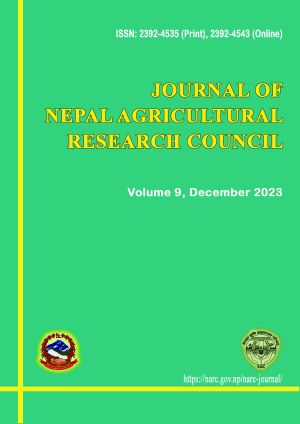Analysis of technical efficiency and yield gap of potato farmers in Nepal
DOI:
https://doi.org/10.3126/jnarc.v9i1.61585Keywords:
Determinants, Elasticity, Stochastic, CoefficientAbstract
The productivity of potato production in Nepal is low compared to neighbouring countries because of a range of production constraints. Potatoes are an important staple crop and commodity for many communities throughout Nepal, thus imperative to improve their performance for the benefit of smallholder producers and consumers. This study aims to identify the technical efficiency and yield gap of potato farmers. Farm-level data from 300 potato farmers randomly selected from three districts of Nepal is used to estimate a stochastic frontier model. The model allows us to estimate the production elasticity coefficients of inputs, determinants of efficiency and technical efficiency of potato farmers. Results showed that among the production variables, seed rate and labour used were positive towards potato production, whereas seed source, extension contact, variety type, and irrigation used were negatively significant factors that influences the technical inefficiency. The mean technical efficiency value of potato farmers was 68%, and there was clear scope to increase potato production by 32% with the better use of available resources. The potential yield gap can be reduced if the adoption of proper agricultural practices such as the use of improved potato varieties with formal seed sources with recommended seed rates along with irrigation application. Such efforts from policymakers and other concerned stakeholders would help improve domestic production and reduce the dependency on potato imports.
Downloads
Downloads
Published
How to Cite
Issue
Section
License
Copyright (c) 2023 Nepal Agricultural Research Council

This work is licensed under a Creative Commons Attribution-NonCommercial 4.0 International License.




